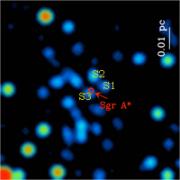Supermassive Black Holes
Radio astronomers are not bothered by dust and have discovered a very bright, point-like object, called Sgr A*, that is probably a super-massive black-hole. At infrared wavelengths one can also see through the dust to the Center, and one sees thousands of stars. But, which of these stars, if any, corresponds to Sgr A*? The problem of identifying the infrared counterpart of Sgr A* exists because it is extremely difficult to align the infrared and radio reference frames to the high accuracy needed to sort out the complex field of stars seen in the infrared image. An RG astronomer and his German collaborators solved this problem by employing stars that are detected both in the radio and infrared to align the two images. The stars used to do this are red giants which are very bright in the infrared and are surrounded by strong molecular maser emission (eg, from water and SiO molecules) at radio wavelengths.
The image shown on the right is an artificially colored infrared image of the inner 2 arcseconds of Galactic Center. All of the bright spots are stars. The position of three stars called S1, S2 and S3 are indicated, along with a circle showing the precise location of Sgr A*. Surprisingly, none of the infrared stars corresponds to Sgr A*! While this solves a long-standing problem in astronomy, the result raises perplexing problems, challenging astronomers to explain how a super-massive black hole in the dense environment of the Galactic Center can be so dim.
Shep Doeleman, Lincoln Greenhill, Michael Johnson, Jim Moran, Rurik Primiani, Mark Reid, Laura Vertatschitsch, Jonathan Weintroub, Jun-Hui Zhao
External Collaborator: James Braatz




